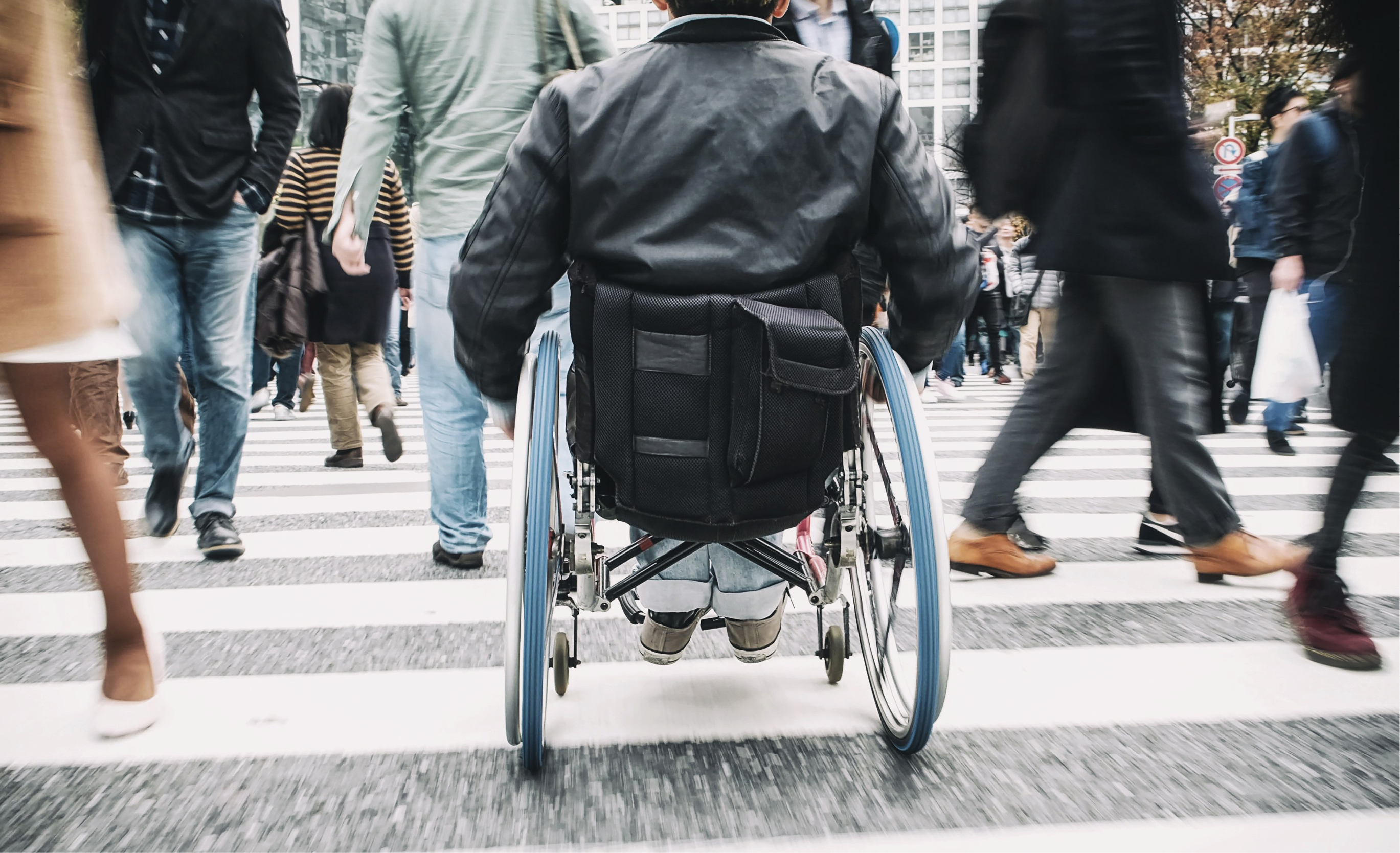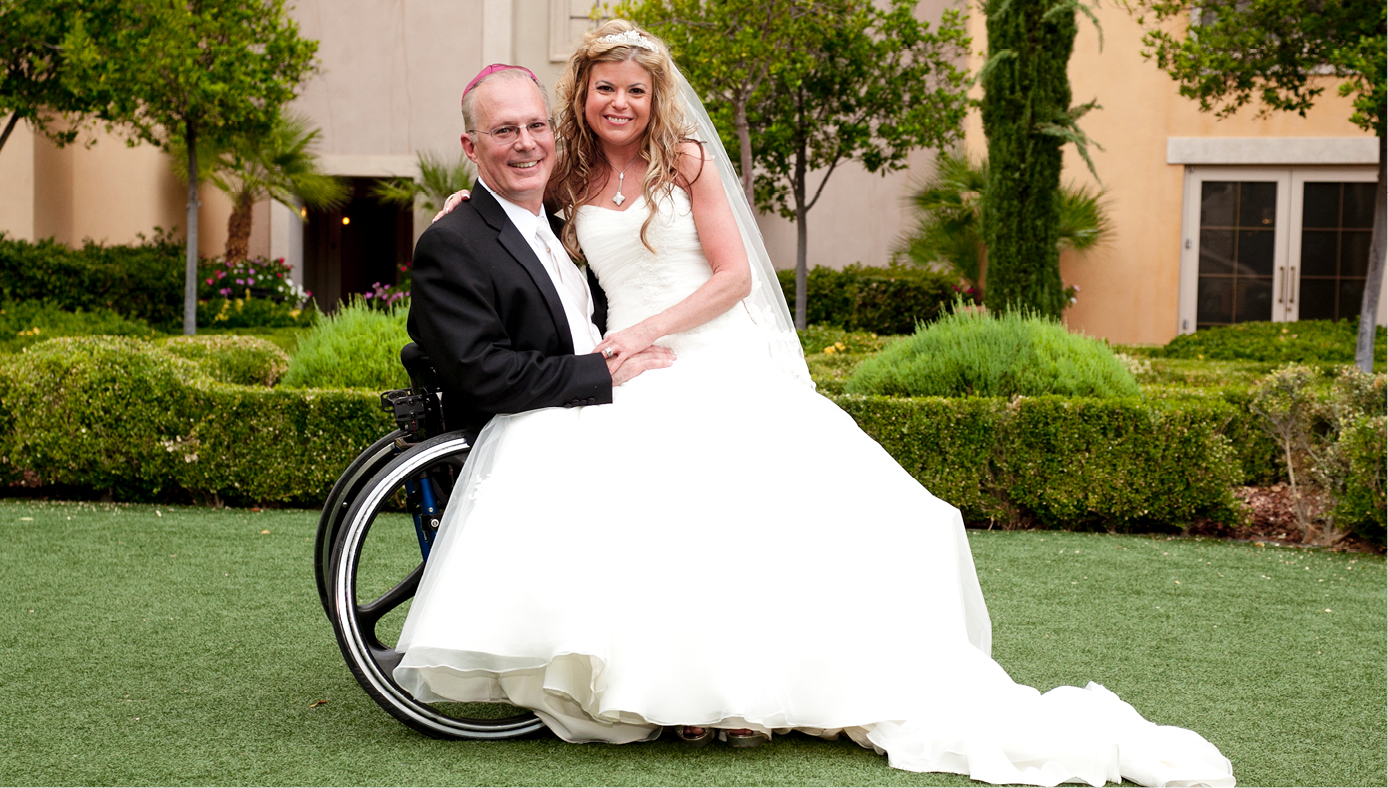Equal Access

It is not said in anger, nor is he downcast. In fact, 50-year-old Michael Rosenblum is decidedly matter of fact as he shares what it’s like not to be able to get around like most people.
“If you’re in a wheelchair like I am and you’re not ready to roll with the punches, you’re going to take a lot of headshots.”
Translation: Because everyday life has largely been designed for the able-bodied, those who are in chairs frequently must deal with physical and attitudinal barriers — and unless they build up the strength to shrug it off, they’ll know far more psychic pain than joy.
The more you talk with Rosenblum, a member of the Jewish Nevada Board of Directors, the more you come to appreciate how important it is that buildings, products, and environments are designed for all people.
You also come to realize how well-meaning people can frustrate those they’re trying to help.
“So often, when my wife and I are out together, whoever comes out to greet and help us only talks to my wife, as though my being in a chair means I can’t talk or think,” says Rosenblum, who laughs and shakes his head. He is a graduate of the Ivy League’s Brown University. “When I was younger, it was the kind of thing that got to me. I let it go now, but I still don’t get it.”
Recently, I visited Rosenblum, his lovely wife Faith, and daughter Emma, at their home in the upper west Las Vegas Valley. Hallways and rooms are wide enough to negotiate in a chair and Rosenblum can easily reach what he must. Laughter fills the living room as they talk about how Rosenblum works out on a punching bag in the garage. They see a backyard swimming pool in their future, after 11-year-old Emma has her bas mitzvah next year.
Born with spina bifida, a birth defect that occurs when the spine and spinal cord don’t form properly, Rosenblum has used a chair since a childhood that saw him undergo more than 20 surgeries. He moved to Las Vegas from New Jersey because he thought the quality of life was better. Now working in sales for Hilton Hotels, he was formerly a partner in North Las Vegas-based Sunshine Fresh, which sells specialty foods. He and his wife love to visit the bar areas of eating spots during happy hours. The only problem is that many bars favor high top tables. “I can jump into the chairs but who wants to do that on a regular basis? They should put out other size tables in the bar area, too.”
“Sometimes, you kinda miss on a jump,” Emma chimes in, pointing out he’s also almost fallen, or actually fell, when trying to navigate stairs or a pot-holed sidewalk with no curb cuts.
Because much of Las Vegas has been built since the 1990 passage of the federal Americans with Disabilities Act (ADA), Rosenblum says its wheelchair accessibility is better than most U.S. cities and certainly better than cities overseas. “I’ve traveled the world and it’s a mess overseas when it comes to accessibility. The ADA may not be perfect, nothing ever is, but it’s civil rights legislation that’s given many people a way to contribute to society and far more accessibility.”
According to federal government statistics, more than 50 million Americans – 18 percent of our population – have disabilities. There are an estimated 3.6 million wheelchair users in the U.S. and the number is increasing more every year as baby boomers age. Nearly 2 million wheelchair users are over age 65.
Like Rosenblum, Ken Small, an architect and owner of SSA Architecture, Small Studio Associates, LLC, says the relative newness of Las Vegas, particularly along the tourist heavy Strip area, has largely contributed to design compliance with the ADA building standards. These include specifications for accessibility in regard to: entrances, doors, gates, rooms, parking spaces, lavatories, light switches, alarm pulls, automatic door controls, wheelchair turning space, and clear floor or ground space.
Buildings constructed before the ADA went into effect are more of a problem, Small says. He explains that when the ADA was created, many buildings were supposed to to get a survey done by an ADA consultant, showing which problems needed to be remediated. Unfortunately, he says, many owners didn’t get the work done by a deadline that has long passed. “That’s why there’s so many lawsuits today,” he says.
If you believe there is a violation of ADA standards, Small says, you should first informally talk to the building manager. If that doesn’t work, then send a certified letter to the owner explaining that you hope the problem is fixed because you don’t want to file a complaint with the U.S. Department of Justice (DOJ). If that fails, then a complaint should be filed with the DOJ. “Once an owner gets a letter from a U.S. Attorney, things get fixed,” says Small, noting that “Grandfather provisions” often found in local building codes do not exempt businesses from their obligations under the ADA. Small also says, however, that complaints to the DOJ can involve lengthy waits for action.
“Owners may not want to make an alteration at first, but after they do, they often find that it helps their business,” Small says.
Because of its tourist business, Las Vegas — which has more wheelchair accessible hotel rooms than any other city — has drawn positive attention from many disability advocates, including Jim Parsons. A retired investment banker from Seattle, Parsons has created https://wheelchairjimmy.com/, a website with tougher standards than the ADA, which rates cities on wheelchair accessibility. For example, unlike the ADA, Parsons only finds it acceptable to provide building entry for wheelchairs through the main property entrance, not through a side or kitchen entrance. Parsons partnered with the William F. Harrah College of Hotel Administration on a ratings project for Las Vegas casinos, hotels, and attractions. On the website you can see videos, reviews, and ratings from both Parsons and students of UNLV Professor Dina Zemke, who teaches a Facilities Management Course.
“The Facilities Management course covers compliance with the ADA, but mere compliance is not the same thing as being hospitable,” Zemke says. “This project helped the students experience first hand how challenging it can be for our guests in wheelchairs to enjoy the hotels, restaurants, casinos, and attractions in the Las Vegas Valley.
Zemke notes that one of her students — they were asked to use wheelchairs in the course — couldn’t participate in studying the resort corridor from wheelchair level. “The student’s parents didn’t want the student to use a wheelchair because they considered it bad luck.”
Parsons gave the Aria Resort and Casino his highest rating, 5, finding both its open public spaces and rooms exceptionally wheelchair friendly. But he also found that the bed height of 30 inches, in the 120 wheelchair accessible rooms, was troublesome for someone trying to get into a bed from a wheelchair. He also said the shower design made it difficult to use. He gave Caesars Palace a low 2 rating, partly because he found there were many steps in the hotel that did not have accompanying ramps.
Yes; all the casinos studied had plenty of slot machines for those in wheelchairs.
Rosenblum is thankful he lives in the United States.
“When you go to some places in the world and ask if they have wheelchair accessible rooms, they don’t even know what you mean,” he says. “When I was in Moscow, I mean they had nothing. They were still carrying people up and down the stairs…I was so glad I stayed in a hotel made by the West.”
He says the best way for new projects to be built today is for them to be accessible to everyone, which is what UNLV School of Medicine Founding Dean Barbara Atkinson plans for the proposed new building for the school.
“Do it right the first time, you don’t want to do things twice,” Rosenblum says.
What Rosenblum doesn’t want to do is file formal complaints about the lack of an accessible design. He prefers to use his personable power of persuasion.
“The last thing I want to do is hurt some mom and pop business,” he says. “I find if I suggest something (like putting a mix of tables in the bar area) it gets done.”
He speaks from experience. While at Brown University in Rhode Island, along with other students, he persuaded the university president to make the school accessible to all students. “[the university president] said ‘tell us what to do and we’ll do it.’ They retrofitted the entire campus over an eight-year period. If people see where you’re coming from,” he notes with satisfaction, “they’ll often do the right thing.”
The ADA guarantees equal opportunity for people with disabilities in public accommodations, commercial facilities, employment, transportation, state and local government services, and telecommunications. ADA standards and guidelines can be found at:

Happily married, Michael and Faith Rosenblum
